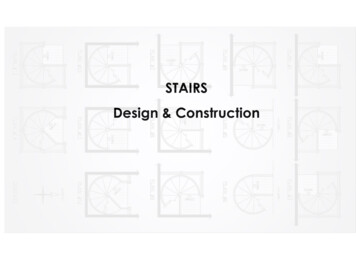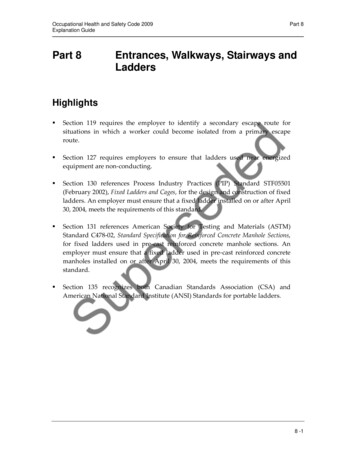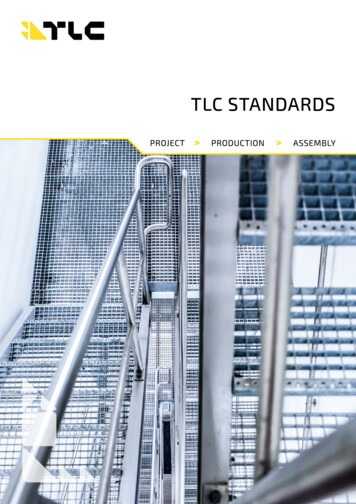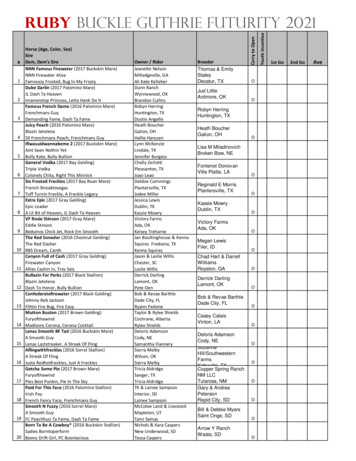
Transcription
STAIRSDesign & Construction
“A Stair is a system of steps by which people and objects may pass fromone level of a building to another.”A stair is to be designed to span a large vertical distance by dividing it intosmaller vertical distances, called steps.Some of the functional requirements of staircases are; Stability protection from fire Suitable dimensions (for normal, elderly, disabled people & children) appearance
COMPONENTS & TERMINOLOGYflight: A series of steps between differentlevels or storeys of a buildinglanding: An area of floor at the top of orbetween flights of stairs for changingdirection in the stairs & providing a restingplace between long flights of stairs.tread - The part of the step that is steppedon.riser - The vertical portion of the stepbetween steps.nosing - An edge part of the tread thatextends from the riser beneath.
winders - Winders are steps that are narroweron one side than the other. They are used tochange the direction of the stairs withoutlandings. A series of winders form a circular orspiral stairway.stringer or string - The structural member thatsupports the treads. There are typically twostringers, one on either side of the stairs;though the treads may be supported manyother ways. The stringers are notched so thatthe risers and treads fit into them.handrail: A rail fixed parallel above the pitchline at the sides of a stair.balusters: Vertical members which support ahandrail.Newel: A vertical post which might providesupport for either the handrail, or support forthe upper end of an outer string.
bullnose – when one or bothsides of the stairs are open, thefirst step above the lower floormay be wider than the othersteps. The rounded portion ofthe step is called a "bullnose".
SUITABLE DIMENSIONS FORSTAIRCASES Riser and tread; in a flight of stairs all stepsshould have the same riser and same tread. Relationship between riser and tread can beshown as 2R T 63cm Convention centers, cinema,Theaters: R 16cm Schools, hospitals, Office buildings R 17cm Residential Buildings R 18cm Steepness of stairs; Regular pitch: 25-36 Open riser stairs
Tread dimensionsMin.Tread width(no side walls) 60cmOne side wall 70cmTwo side walls 80cm
HandrailsHandrails height should bebetween 86.5- 96.5 cm.Handrails may project a max.of 9cm into the required width.
Minimum Headroom – 200 cm.
Headroom calculationH 140 70/CosαPitch : 20 H 215cmPitch : 30 H 220cm:Pitch : 45 H 240cm
Types of Staircases (Plan types) Straight run180 degree returnL shapedSpiral
Straight Run Stairs Simplest form of stairarrangement Consists of onestraight flight of stairslinking two levels. The width and thelength of the landingsshould be equal(max.120cm).
180 Degree Return Stair Open well withtwo flights; Spacebetween thelower and upperflights causes halfspace landing tobe longer.Dog leg Dog leg: Twoshort flights with ahalf spacelanding betweenthem. Outer strings oftwo flights lie inthe same verticalplane.
L Shaped Stair L shaped stair mayhave either equal orunequal flights
WINDER STAIRS“Winder" or "curved"stairs refer to stairwaysthat make a turn withoutincluding an intermediatelanding or platform toprovide a flat rectangularturning space.Min 10cm
Landing Types
Landing Dimensions
Spiral Stairshave treads which turn and risearound a central column.Diameter : 1900mm(The opening left for spiralstaircases is 15 cm morethan the diameter.)
Vatican Museum Staircase
CONCRETE STAIRSCONSTRUCTION TYPES
CONCRETE STAIRDRAWINGS
WOODEN STAIRCONSTRUCTION TYPES
METAL STAIRSCONSTRUCTIONTYPES
How to draw a detailed stair plan:1. Number each of the steps starting from the lowest2. Indicate all the dimensions like tread widths & depths, total length & width ofthe stair, balustrade details etc.3. Specify all the different types of materials.
How to draw a detailed stair plan:1. Number each of the steps starting from the lowest2. Indicate all the dimensions like tread widths & depths, total length & width ofthe stair, balustrade details etc.3. Specify all the different types of materials.
PLAN DRAWING OF A STAIRCASE
BALUSTRADES
BALUSTRADECONNECTIONDETAILS
Open riser treads
Cable rails- Cable railing requires very rigid frames compared to many othertypes of railings due to the forces applied to the end posts by tensioning thecables. Cables must be tensioned to provide a rigid as possible condition tosatisfy building code requirements. Common frame types are constructed of44steel, stainless steel, extruded aluminum or wood.
REFERENCES1.Ashcroft, R., Construction for InteriorDesigners, 1992, England2. Ching, F.D.K, Building ConstructionIllustrated, 2001.3.Sari,Abdullah, Merdivenler, 1994, Turkey4.www.mustknowhow.com5.www.gharexpert.com
“A Stair is a system of steps by which people and objects may pass from one level of a building to another.” A stair is to be designed to span a large vertical distance by dividing it into smaller vertical distances, called step










